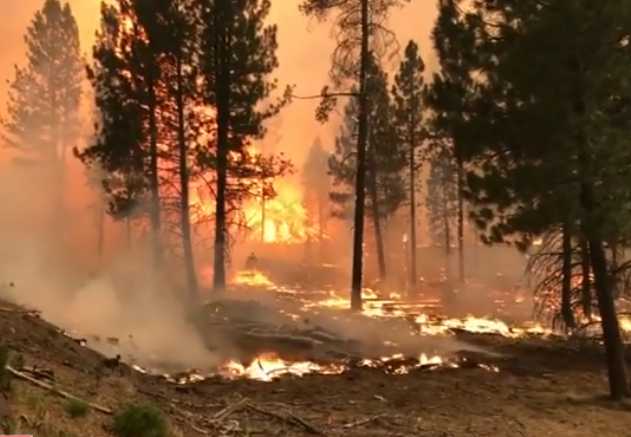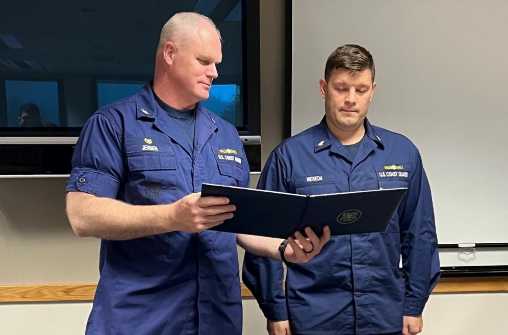“Normally the weather predicts what the fire will do,” said an Oregon official. “In this case, the fire is predicting what the weather will do.”

As of Tuesday morning, the Bootleg Fire had burned up more than 364,000 acres across Southern Oregon—becoming so big that not only has it bolstered the case for bold climate action, the fire is also creating its own weather.
“The fire is so large and generating so much energy and extreme heat that it’s changing the weather,” Marcus Kauffman, a spokesperson for the Oregon forestry department, told The New York Times. “Normally the weather predicts what the fire will do. In this case, the fire is predicting what the weather will do.”
The newspaper noted that such extreme fires “confound firefighting efforts. The intensity and extreme heat can force wind to go around them, create clouds, and sometimes even generate so-called fire tornadoes—swirling vortexes of heat, smoke, and high wind.”
“It’s kind of an extreme, dangerous situation.”
The Bootleg Fire in Oregon, the largest U.S. wildfire so far this year, is so extreme that it’s affecting winds and disrupting the atmosphere. https://t.co/p1gfL1LZQf
— The New York Times (@nytimes) July 19, 2021
Noting that Oregon officials have said the Bootleg Fire is showing “aggressive surface spread with pyrocumulus development,” CNN explained Tuesday:
Pyrocumulus clouds form when extreme heat from the flames of a wildfire force the air to rapidly rise, condensing and cooling any moisture on smoke particles produced by the fire. These clouds essentially become their own thunderstorms and can contain lightning and strong winds.
Kauffman warned the fire, which is the third-largest in state history, could continue to grow. It is burning “dense fuels that are extremely dry from a prolonged drought,” he told CNN. “Up until today, the weather has been consistently hot, dry with near single-digit humidity.”
Given concerns about drought, dry conditions, and recent record heat in the region, the Associated Press reported, “resources like fire engines are being recruited from places like Arkansas, Nevada, and Alaska.”
The Bootleg Fire in Oregon is among at least 83 large fires burning across 13 states, which have collectively consumed nearly 1.3 million acres, according to the National Interagency Fire Center. Other fires around the world are also alarming activists and scientists alike.[content id=”79272″]
The Guardian on Sunday published a photo series that featured not only the Bootleg Fire but also blazes from California to Greece, devastating floods across Europe and Australia, and sandstorms in China.
In response to the series, the U.S. advocacy group Food & Water Watch tweeted Tuesday that the climate crisis “isn’t some far-off future. It’s already here.”
Devastating & often record-setting extreme weather events like these are consistent with the predictions of a climate-changed world.
Wishing courage and strength to all those affected.#ActOnClimatehttps://t.co/JeICkygCXx— Greenpeace (@Greenpeace) July 20, 2021
The extreme weather events across the globe have raged on as the Biden administration and congressional leaders have been negotiating federal infrastructure and jobs legislation in the face of demands from progressive lawmakers and advocacy groups that any package include ambitious climate action.
U.S. Rep. Pramila Jayapal (D-Wash.), chair of the Congressional Progressive Caucus, pointed to the dozens of fires burning across the West—including in her state—as evidence of the need to enact climate policies that match the scale of the global emergency humanity has created.
“We must respond at the scale of the crisis before it’s too late,” she said Tuesday. “The future of our communities, environment, and planet depend on us acting now.”
This is why we call it a climate crisis.
We must respond at the scale of the crisis before it’s too late. The future of our communities, environment, and planet depend on us acting now.https://t.co/zmQsocN7Dm
— Rep. Pramila Jayapal (@RepJayapal) July 20, 2021
Meanwhile, as Common Dreams reported earlier Tuesday, the International Energy Agency (IEA)—which in May made clear that the world needs to stop pouring money into fossil fuels—warned that global carbon dioxide emissions are on track to reach record levels in 2023 as rich nations fail to invest in clean energy.
While calling out governments that promised a green recovery from the pandemic but declined “to put their money where their mouth is,” IEA executive director Fatih Birol emphasized that they must lead clean energy advancement “to much greater heights beyond the recovery period in order to shift the world onto a pathway to net-zero emissions by 2050, which is narrow but still achievable—if we act now.”
Common Dream’s work is licensed under a Creative Commons Attribution-Share Alike 3.0 License. Feel free to republish and share widely.
[content id=”79272″]





